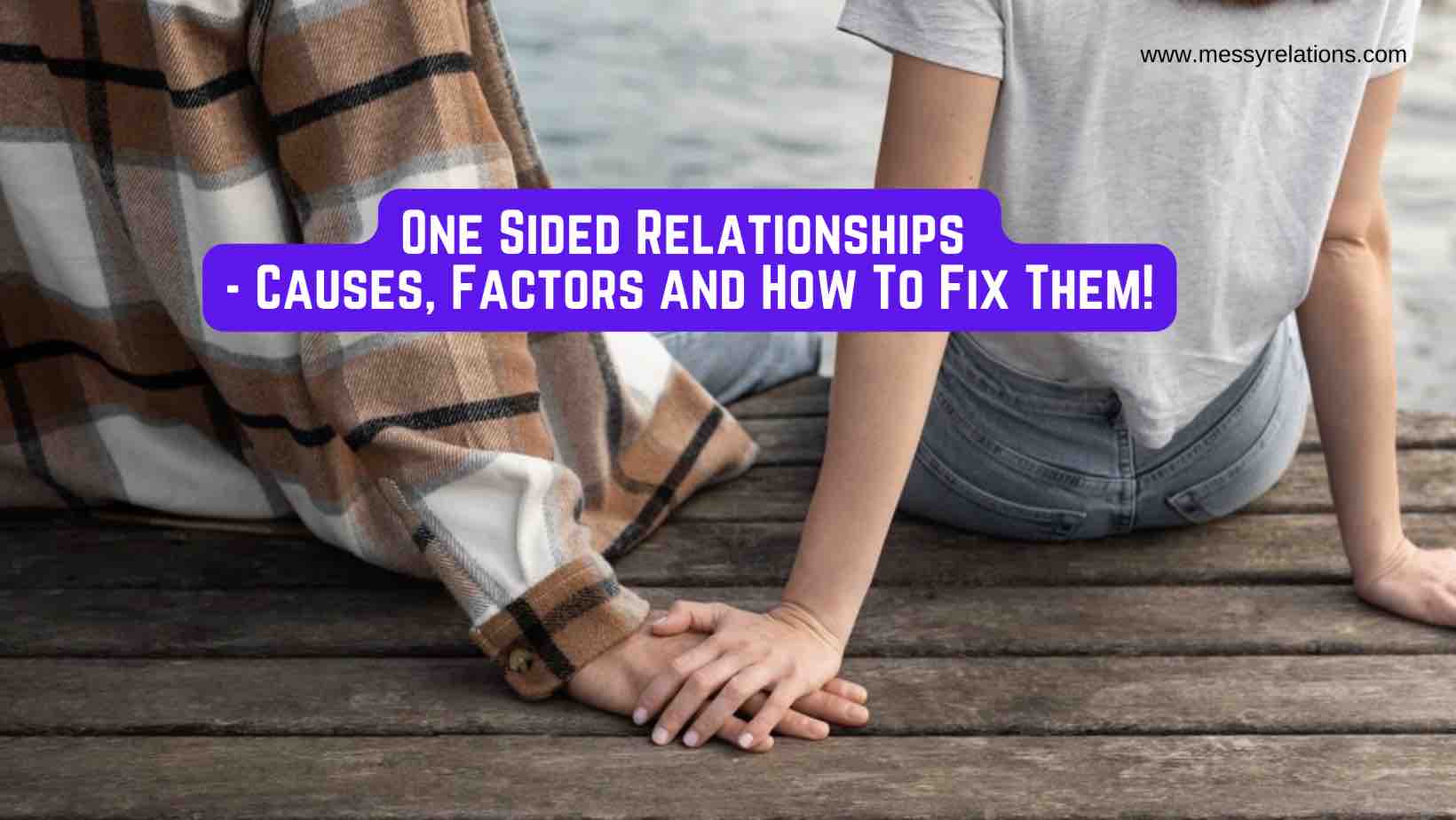In the world of relationships, balance is key. However, not all relationships maintain this equilibrium, leading to what are often termed as one-sided relationships. Understanding the one sided relationships causes is essential for those who find themselves in such dynamics or want to avoid them in the future. This article aims to delve into the various factors that contribute to the development of such unbalanced relationships and a guide on how to fix one sided relationship so stay tuned. Let’s first begin with What Causes One Sided Relationships?
What Causes One Sided Relationships?
Lets see what exact are the common one sided relationships causes:
1. Fear of Confrontation and Conflict
One of the primary causes of one-sided relationships is the fear of confrontation. Often, one partner might feel uncomfortable addressing issues or expressing dissatisfaction, leading to a dynamic where their needs and desires are consistently sidelined.
2. Low Self-Esteem and Self-Worth
Individuals with low self-esteem might find themselves in one-sided relationships because they believe they don’t deserve better. This lack of self-worth can make them settle for less than they deserve, accepting minimal effort from their partner.
3. Past Trauma and Relationship Patterns
Past traumas, especially those stemming from childhood or previous relationships, can significantly influence how people engage in relationships. Those who have experienced neglect or abandonment might unconsciously gravitate towards partners who exhibit similar behaviors, perpetuating a cycle of one-sided dynamics.
4. The Desire to Please and Be Accepted
The innate desire to please others and be accepted can also lead to one-sided relationships. This can result in one partner constantly giving and adjusting to meet their partner’s needs, neglecting their own in the process.
5. Imbalance in Emotional Investment
One-sided relationships often occur when there’s a significant imbalance in emotional investment between partners. One partner might be deeply invested in the relationship, while the other remains emotionally distant or disengaged.
6. Communication Breakdown
Effective communication is the backbone of any healthy relationship. A breakdown in communication can lead to misunderstandings and assumptions, often resulting in one partner feeling neglected or undervalued.
7. Power Imbalances
Power imbalances, whether due to financial, emotional, or social factors, can contribute to one-sided relationships. When one partner holds more power, it can skew the relationship’s dynamics, leading to one partner having most of the control and influence.
8. Unaddressed Mental Health Issues
Mental health issues, if left unaddressed, can play a significant role in creating one-sided relationships. Issues like depression, anxiety, or personality disorders can affect a person’s ability to participate fully and equitably in a relationship.
9. Lack of Shared Interests and Values
A lack of shared interests and values can lead to one partner being more invested in the relationship. This disparity can create a situation where one partner is constantly striving to align with the other’s interests and values, often at the expense of their own.
10. Ignoring Early Warning Signs
Often, one-sided relationships develop because early warning signs are ignored. Individuals might overlook or excuse behaviors that indicate a lack of balance in the early stages of the relationship, leading to more significant issues down the line.
Understanding the causes of one-sided relationships is crucial for both preventing them and addressing them when they occur. Recognizing these signs early on can lead to healthier, more balanced relationships, where both partners feel valued and heard.
What Are The Reasons Behind One-Sided Relationships?
In the intricate dance of relationships, sometimes the rhythm gets disrupted, leading to a one-sided relationship. Such relationships are characterized by an imbalance where one partner invests significantly more—emotionally, physically, or financially—than the other. Understanding the reasons behind this imbalance is crucial for those seeking healthier, more fulfilling connections.
1. Fear of Being Alone
A common reason people stay in one-sided relationships is the fear of being alone. This fear can make individuals tolerate less-than-ideal situations because they believe a one-sided relationship is better than no relationship at all.
2. History of Unhealthy Relationships
Individuals with a history of unhealthy relationships, especially from childhood, might unknowingly replicate these patterns. They might perceive one-sided devotion as normal, continuing the cycle without realizing it’s unhealthy.
3. Differences in Love Languages
Sometimes, a one sided relationship arises from differences in love languages. One partner might express affection in ways the other doesn’t recognize or value, leading to feelings of imbalance and neglect.
4. Disparity in Emotional Availability
Emotional availability varies from person to person. A one-sided relationship can develop if one partner is emotionally open and invested, while the other is distant or guarded, creating an imbalance in emotional depth and connection.
5. Lack of Effective Communication
Effective communication is the cornerstone of any healthy relationship. In its absence, misunderstandings and unmet expectations can flourish, often leading to one partner feeling more invested than the other.
6. Desire for Validation and Approval
The need for validation and approval can sometimes lead to a one sided relationship. This need might drive one partner to go above and beyond to please the other, often at the cost of their own needs and happiness.
7. Unequal Effort in Relationship Maintenance
Relationships require effort from both parties. A one-sided relationship can emerge when one partner consistently puts in more effort to maintain and nurture the relationship than the other.
8. Overlooking Personal Boundaries
Ignoring one’s personal boundaries can lead to a one-sided relationship. When one partner consistently sacrifices their needs, wants, and boundaries to accommodate the other, it creates an imbalanced dynamic.
9. Imbalance of Power and Control
Power dynamics play a crucial role in the health of a relationship. An imbalance where one partner dominates decisions, finances, or other aspects can lead to a one-sided dynamic.
10. Unresolved Personal Issues
Individuals dealing with unresolved personal issues, such as low self-esteem, dependency issues, or past traumas, might find themselves in one sided relationships. These personal struggles can affect how they perceive and engage in relationships.
Knowing the reasons behind a one-sided relationship is the first step toward addressing and rectifying the imbalance.
How to Fix a One-Sided Relationship?
Finding yourself in a one-sided relationship can be disheartening and challenging. It’s a situation where one partner feels they are putting more into the relationship than they are receiving. However, recognizing this imbalance is the first step towards making positive changes. Let’s now explore practical ways to fix a one-sided relationship, aiming to restore balance and harmony.
1. Accept there’s Imbalance
The first step to fix a one-sided relationship is acknowledging that the imbalance exists. This involves both partners being honest with themselves and each other about their feelings and the state of their relationship.
2. Be Open in Communication
Open, honest communication is crucial. It’s important to express your feelings and concerns without blaming or attacking your partner. Instead, focus on how the situation makes you feel and express a desire to work together to improve the relationship.
3. Evaluate Your Needs and Expectations
Both partners should take time to evaluate their needs and expectations in the relationship. Understanding what you need from your partner and what they need from you can help clarify where the imbalance lies.
4. Establish Boundaries
Setting healthy boundaries is essential. This means communicating your limits and the things you are not willing to compromise on. Boundaries help ensure that both partners’ needs are respected and met.
5. Encourage Mutual Effort
A relationship is a two-way street. Encourage your partner to participate actively in the relationship. This could involve making decisions together, sharing responsibilities, or supporting each other’s goals and interests.
6. Practice Empathy
Try to understand things from your partner’s perspective. Empathy can help bridge the emotional gap and foster a deeper understanding of each other’s feelings and actions.
7. Prioritize Quality Time
Spending quality time together can help strengthen your bond. Engage in activities that both of you enjoy and that allow for meaningful interaction and connection.
8. Seek Professional Help If Required
Sometimes, the best way to fix a one-sided relationship is to seek help from a professional. Couples counseling can provide the tools and guidance necessary to address the issues in your relationship effectively.
9. Focus on Personal Growth
Working on personal growth can have a positive impact on your relationship. Developing your interests, friendships, and self-care practices can improve your well-being and, in turn, the health of your relationship.
10. Reevaluate the Relationship
If, despite your efforts, the relationship remains one-sided, it may be time to reevaluate whether this relationship is right for you. It’s important to be in a relationship where you feel valued, respected, and fulfilled.
Fixing a one-sided relationship requires effort, patience, and a willingness to change from both partners. Through open communication, mutual effort, and professional help when needed, it is possible to transform a one-sided dynamic into a more balanced and satisfying relationship. Remember, both partners deserve to feel loved and valued in a healthy relationship.
FAQs on One-Sided Relationships
1. What are the main indicators of a one-sided relationship?
Key indicators of a one-sided relationship include feeling consistently undervalued, having your needs and desires overlooked, and carrying the bulk of emotional or financial responsibilities. If you find yourself making all the efforts to maintain the relationship, it’s likely one-sided.
2. How can I effectively communicate my feelings in a one-sided relationship?
Communication should be open and non-confrontational. Use ‘I’ statements to express how you feel and what you need, rather than pointing fingers. It’s also crucial to choose the right time and setting for these conversations to ensure your partner is receptive.
3. Can a one-sided relationship ever become balanced again?
Yes, a one-sided relationship can become balanced if both partners are willing to acknowledge the issues and work on them. This often involves open communication, setting boundaries, and sometimes seeking professional help.
4. What role does self-care play in dealing with a one-sided relationship?
Self-care is vital. It helps maintain your emotional and mental health, ensuring you don’t lose yourself while trying to balance the relationship. Activities that boost your self-esteem and independence can be particularly beneficial.
5. When is it time to consider ending a one-sided relationship?
If after making sincere efforts to fix the imbalance there’s no change, or if the relationship is taking a toll on your mental health and well-being, it might be time to consider ending it. Relationships should be mutually beneficial and respectful.
6. How can counseling help in a one-sided relationship?
Counseling can offer a neutral platform for both partners to express their concerns. A therapist can provide insights and tools to improve communication, understand each other’s perspectives, and work on the relationship’s issues more effectively.
7. What are some strategies to rebuild a one-sided relationship?
Rebuilding a one-sided relationship involves restoring balance. This can be done through effective communication, spending quality time together, showing appreciation for each other, and both partners actively participating in the relationship.
8. Is it common to feel guilty for wanting more balance in a relationship?
Feeling guilty is common but unwarranted. Wanting a balanced relationship where you feel valued and appreciated is a reasonable and healthy desire. It’s important to recognize your worth and seek a relationship dynamic that respects that.




